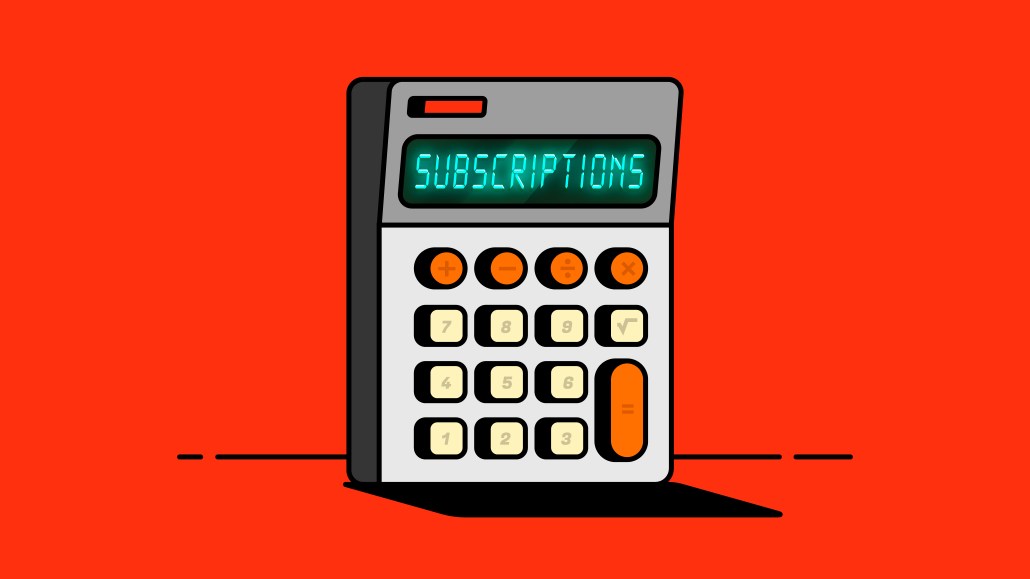As news subscriptions stall, the U.S. market is faring better than most

Globally, subscription growth for news organizations has turned sideways, according to the Reuters Institute’s latest Digital News Report published on Wednesday. Across 20 countries, the average proportion of the roughly 40,000 survey respondents paying for digital news subscriptions has remained at 17% for the second year in a row.
This raises “questions about whether we may have, for now, reached the peak of the subscription trend, at least for current subscription offers,” reads the report.
The U.S. market is faring slightly better: 21% of the roughly 2,000 people in the U.S. survey sample are paying for online news, up from 19% in the Reuters Institute’s report from last year.
However, there are some indicators that digital subscriptions are also starting to stall in the U.S.
A media executive — who traded anonymity for candor — told Digiday their publication has seen a single-digit drop in subscriptions in Q1 2023 compared to Q1 2022, which they said they considered “a win … because of where the marketplace is right now.”
“I’m not surprised that [this] report suggests softness in the subscription marketplace given where we are economically right now,” they said.
The Reuters Institute surveyed a portion of each market’s sample group to determine what proportion had canceled or renegotiated subscriptions in the last year, and found that 47% of 155 people surveyed in the U.S. had done so.
When looking at all 20 markets in the report, around one in five news subscribers (23% on average) said they have canceled at least one of their ongoing news subscriptions, while the same percentage said they have negotiated a cheaper price.
Among those who have canceled their subscriptions in the last year, cost of living or high subscription prices were cited most often as the reason.
Checking in on publishers’ subscriptions
The Washington Post — whose CEO Fred Ryan stepped down this week — has stalled at 2.5 million digital subscribers in the past year. That’s a decrease from the 3 million subscribers The Post said it had in 2021.
Meanwhile, the Los Angeles Times doubled its digital subscriptions from 225,000 in 2020 to 450,000 in 2022. But in the past year, that number has grown only by about 100,000 subscribers, the publication self-reported.
Time removed its paywall entirely this month. CEO Jessica Sibley said the company wanted to reach a larger global audience with its journalism and will produce more ad-supported content on its digital platforms, according to Axios. Time had 250,000 digital subscribers.
Variety — though notably more of a trade publication than a general-interest news outlet — added a lower-priced tier to its subscription product last week, Andrew Wallenstein, Variety Intelligence Platform president and chief media analyst, told Digiday. Variety’s VIP+ premium subscription is $420 a year, compared to the new tier called VIP+ Vitals that costs $240 a year or $20 a month.
“Editorial subscription products have to be at the top of their game in a challenged marketplace if they want to avoid feeling the pain on their bottom lines,” Wallenstein said. “At VIP+, that means continuing to evolve the product in many different ways — pricing, marketing, content strategy — so that we stay reactive to changing customer needs.” Wallenstein declined to share how many VIP+ subscribers Variety has.
But it’s not all bad news. The New York Times Company has added 790,000 digital-only subscribers since Q1 2022 and now has over 9 million digital-only subscribers.
The Wall Street Journal had 3.3 million digital subscriptions in the third quarter of its fiscal year 2023 (ending March 31), a 9% increase compared to the same period last year and an addition of 132,000 from the previous quarter.
The Atlantic now has over 900,000 subscriptions, 54% of which are digital, a spokesperson said. That’s up from 860,000 at the end of 2022. The Atlantic introduced a dynamic paywall at the start of this year. The aim is to gain about 125,000 subscribers split across the next two years by implementing its new “smart meter” strategy, Atlantic CEO Nick Thompson told Digiday last December.
What drives readers to pay
Respondents to Reuters Institute’s survey said they might pay for content if it was more distinctive (22% said this), if there was an ad-free option (13%) or if the price was cheaper or provided more flexibility (32%).
However, 42% of respondents said that nothing would persuade them to pay.
More in Media

A timeline of the major deals between publishers and AI tech companies in 2025
Here’s a list of all the major deals signed between publishers and AI tech companies in 2025.

No playbook, just pressure: Publishers eye the rise of agentic browsers
For the bulk of publishers, Google is, as ever, the one to watch. It’s already got agentic features within its Chrome browser, but that’s the tip of the iceberg, some say.

The biggest SEO lessons in 2025 for publishers
KPIs are changing, more AI search data is becoming available, and publishers are looking beyond search to grow their audiences and revenue.








